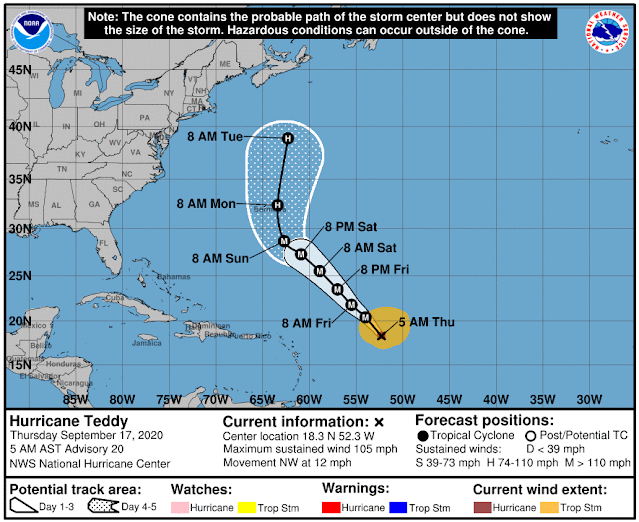I've been a bit scarce around here since Friday; yesterday, we attended a going away party for some dear friends who moved over to the far side or Orlando from here, so about 90 miles away. In the big picture sense, not that far, but still far enough so that we won't see them every couple of weeks like we're used to. The party took some prep time yesterday, and lasted longer/later than expected. Today has been catching up. So a couple of smaller post topics that are interesting but don't need a longer post.
It's not really news, but just to confirm it, the end of solar cycle 24 was marked last December, and
we're now firmly in cycle 25. NASA and NOAA made the announcement on the 15th. The number of
cycle 24 spots has been in decline, and while the first cycle 25 spot was seen
over a year ago, the cycle 24 spots seem to have stopped.
“How quickly solar activity rises is an indicator on how strong the next solar cycle will be,” says Doug Biesecker of NOAA’s Space Weather Prediction Center, co-chair of the Solar Cycle 25 Prediction Panel. “Although we’ve seen a steady increase in sunspot activity this year, it is slow.”
Unfortunately, that leading sentence is a bit of a problem. You see, according to SpaceWeather.com, as of today, the sun has been spotless 30 days. For the year, the sun has been spotless 186 days, or 70% of the year. Not exactly a gangbusters start.
Last Thursday, the 17th, SpaceX had scheduled the launch of their next bunch of Starlink Internet satellites. The launch was scrubbed with something like 10 minutes left in the countdown. It was quickly rescheduled for the following day, and almost as quickly scrubbed again. It took at least another day for us to find the reason: the booster recovery drone ship was unable to remain stationary in the ocean currents off the southeast coast.
The major reason for the strong currents going out of range that the ship's
thrusters can handle is the effects of Hurricane Teddy in the Atlantic basin,
southeast of Bermuda. A second consideration is that being close to the
fall equinox, tides and tidal currents are higher than normal - even more so
with the moon close to being a New Moon on the equinox as it is. Last
Thursday, the day of the mission scrub, the hurricane was quite far from
Bermuda:
For reference the drone ship (in this case, Just Read The Instructions, JRTI)
is deployed northeast of Cape Canaveral, about 350 to 400 miles out.
That puts it around the latitude of the Georgia/South Carolina border.
The storm is still south of that latitude; it's due east of Cape
Canaveral as of the 2PM update.
[in a tweet...] Musk revealed that SpaceX means for its drone ship “thrusters to be upgraded for future missions,” an obviously intuitive response to drone ships being overpowered by ocean currents. There’s one simple problem, though: drone ship Just Read The Instructions, the same ship currently unable to hold its position in (admittedly strong) ocean currents, completed extensive upgrades just a handful of months ago.
JRTI now has thrusters bigger than those on her sister ship, Of Course I Still Love You, so I'm assuming JRTI was sent on this flight because it can withstand higher currents than OCISLY. Both will need to be upgraded.
My guess is that JRTI will be able to handle the currents later in the week. By Wednesday, Teddy will be in the Canadian Maritime Provinces headed for Greenland and the Atlantic basin will be calming back down. We'll also be on the other side of the equinox, with the moon approaching first quarter next weekend. All of those seem to line up for lower currents.
Finally, over in Boca Chica, Starship prototype serial number 7.1 is still intact. They have yet to actually test the prototype to bursting, but have gone through several other tests with cryogenic loads. The next tests are scheduled for Monday night through Tuesday morning. Tropical storm Beta is currently making news in the Gulf, but the southernmost portion of the Texas coast, where SpaceX is located, is not under tropical storm watches or warnings and it should be possible to do the tests.
This is SN7.1 last Saturday. At the moment, the camera framing is different, but 7.1 looks the same.


Over at Teslarati, there is speculation that SN8 may be rolled to the test stand since the hydraulic test rams were move to the launch use test stand closer to the tank farm. The thinking is that SN8 will undergo initial ambient and cryo pressure tests and then be moved back for installation of the fins and nosecone. Glad they are moving on quickly.
ReplyDeleteI'm sure you saw this, but for others who might read this, last week Musk tweeted that SN8 should be ready for testing to start "next week." Speculation is they would do a bunch of tests with the potential to destroy it; cryogenic tests, pressure tests, static firing (probably with three raptor engines instead of one) and build it the rest of the way up. That would be followed by some verification tests before a hop to much higher altitudes than the previous tanks have hopped.
DeleteStarship is going to have a unique flight profile before landing. Sort of a belly flop for air resistance, followed by a vertical flip while lighting the engines and then landing nose up with the Raptors firing. They need to take it high to get enough time and speed to test that maneuver.
They're scheduled for a road closure and testing overnight tonight. It seems possible they test to tank failure, then roll SN8 to the pad while cleaning up the SN7.1 mess goes on.